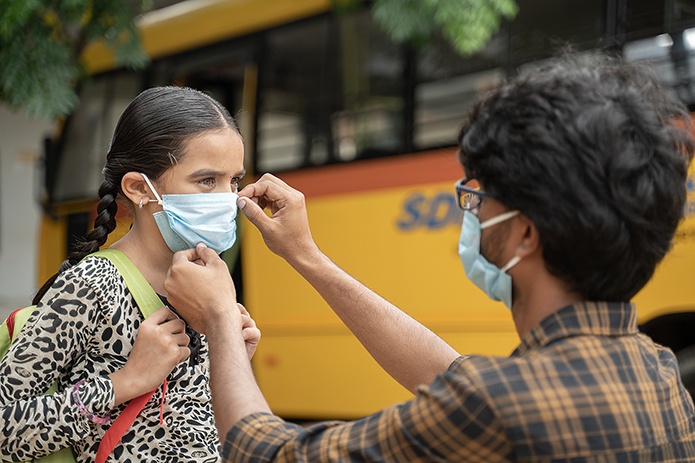
United Safety is pursuing a multi-tiered approach to school bus safety, aiming to help pupil transportation providers face new paradigms and challenges.
The spread of COVID-19 throughout the nation – and the ensuing challenges which statewide lockdowns placed on bus travel – was the catalyst for some elements of this holistic safety view. Jeff Krueger, vice president of field operations for United Safety, said that this offering is critical to help restore confidence in pupil transportation in the wake of those events.
Ken Hedgecock, national sales manager for United Safety with a focus on the school bus industry, said the company has four major pillars or offerings, to help increase pupil transportation safety.
“For school buses, our approach consists of fire suppression, automated child safety alarm, air purification, and surface protectants,” Hedgecock said.
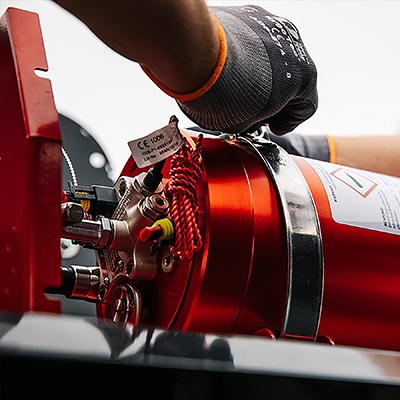 Fogmaker Fire Suppression
Fogmaker Fire Suppression
United Safety is the North American distributor of Fogmaker, which produces fire suppression systems with high-pressure water mist for engine compartments or other closed areas.
The key feature of the Fogmaker system is that it is water based. That water-based system, Hedgecock said, is unique because it attacks all three “legs” of a fire: flame, oxygen, and fuel.
“A fire needs those three legs in order to spread,” he said. “When the water first hits the flame or heat source, it creates steam – thereby driving oxygen away from the fire. It then eliminates the flame because the water can take a 600-degree fire down to 80 or 90 degrees within seconds. Finally, it coats the fuel source to help protect against reflashes.”
Hedgecock said the Fogmaker system deploys for 45 to 60 seconds, a longer deployment cycle which helps keep the fire down for a longer period.
The system is 100-percent mechanical, so it does not rely on any electrical sensors for deployment.
“When the temperature in the protection compartment reaches 350 degrees Fahrenheit, the system’s detection tube melts and that pressure opens up with system’s water storage containers,” he said. “It relies on no electrical signals, which is critical if there is an electrical loss in the vehicle.”
He added that the system will deploy regardless of the vehicle’s configuration. Whether the bus is upside down, on its side, or standing correctly, the system will deploy without fail. This is because the Fogmaker system’s deployment relies on pressure as opposed to gravity.
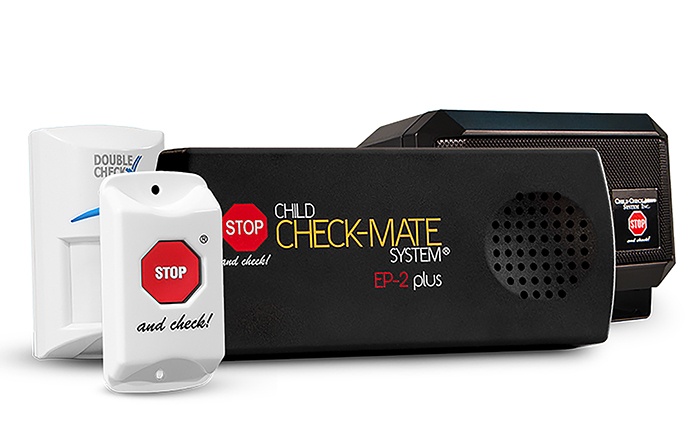
Child Check-Mate
Designed by drivers for drivers, the Child Check-Mate alarm system was the brainchild of a school bus operator and an ingenious mechanic. United Safety said this system has saved the lives of hundreds of children by acting as an electric reminder to drivers.
“Child Check-Mate is by far the premier system of its kind in the marketplace,” Mirabile said. “This system, which we added to our portfolio in 2019, is in more school buses than any other child-detecting alarm.”
The easy-to-install system is simple to use and simple to train, featuring a child check function to remind drivers to check for children at the end of each route. A secondary alert horn will sound if the check is not complete.
Unique tones prompt drivers and indicate system status, and the system can be programmed to meet various district requirements and state/county regulations.
The system has expanded capabilities which now include motion sensing and alerts via Wi-Fi. It can also remotely activate the vehicle’s heating or cooling system to give school officials more time to reach a child who was left behind. Furthermore, the system has a voice module which allows adults to speak to a child that may be on the bus – allowing them to calm and assure the student that help is on the way.
The system’s motion-detection capabilities also allow it to act as a theft protection device. If someone steps on the bus to steal or vandalize it, the system will activate and alert school officials.
“Adoption of a child check system has been fairly universal in the school bus industry,” Hedgecock said. “Adoption of our system, which provides the additional fail safe and asset protection, has been very, very strong as well. First Student, the largest single operator of school buses in North America, employs our system on all its buses.”

Active Air Purification
Because COVID-19 is transmitted through aerosols, onboard air treatment has become a major priority for school buses and classrooms. United Safety has partnered with RGF® Environmental Group, Inc. to bring Active Air Purification to school bus transportation. RGF – a 35-year-old company which manufactures over 500 environmental products – provided the ultraviolet photohydroionization (UV-PHI®) technology which powers the Ative Air Purification System.
The PHI® process creates low-dose hydrogen peroxides which then get dispersed into the air within the bus, where they attack and eliminate airborne pathogens such as the SARS-CoV-2 airborne molecules, the virus that causes COVID-19. The system actively and continuously purifies onboard air so that it “mimics” natural, outdoor air, where transmission of SARS-Cov-2 (which causes COVID-19) and other viruses is very rare. Although it is a new concept for American bus transportation, PHI® technology is widely used in government buildings by the FBI, CIA, military facilities around the country, and even in Chipotle locations across the United States, to prevent virus and bacterial spread.
The Active Air Purification system produces levels of hydrogen peroxide that are only 2 percent of OSHA’s recommended maximums for contained environments, and is safe for the materials of a bus’s interior. As opposed to other, passive solutions on the market. Active Air Purification is unique because it is always actively eliminating airborne contaminants.
In onboard test environments, the system is maintaining bacteria levels equivalent to hospitals and food processing centers – even without daily disinfection. This is a result of the system’s ability to engineer outdoor air quality indoors.
The only required system maintenance is an annual cell replacement (the cell consists of the UV bulb and the catalyst agent).
“Millions of buildings in America have been using this technology for decades, and now it is our job to deploy it as quickly and meaningfully as possible aboard vehicles,” said Joseph Mirabile, president and CEO of United Safety. “If PHI® technology had been deployed on pre-pandemic transportation, we would have had a much better chance at stopping the spread in public environments.”
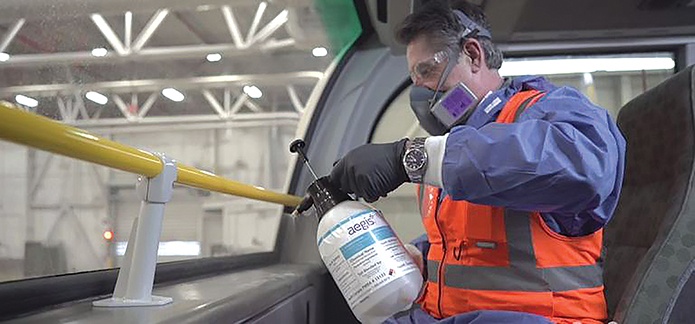
AEGIS® Microbe Shield
United Safety was already in the process of innovating onboard surface treatments when the pandemic struck. The company debuted AEGIS® Microbe Shield, an antimicrobial surface treatment utilizing nanotechnology.
After the microbe shield is applied to a surface, it essentially creates a surface barrier that lasts for a minimum of six months and up to a maximum of 12 months depending on usage (12 months for a school bus application). The layer is invisible, and not detectable to human touch – but it effectively punctures and kills 99 percent of bacterial particles with which it comes into contact.
“For a few years now, we have seen AEGIS® as a product which helps the school bus operators provide cleaner onboard environments in between regular cleaning cycles,” said Ray Melleady, executive vice president of United Safety. “Most schools have traditionally disinfected buses once per week, with deep clean disinfections occurring once per month. This technology allows districts to keep surfaces extremely clean from pathogens in between those cleaning cycles.”
Hedgecock said it is important to note that the two antimicrobial products – Active Air Purification and AEGIS – are not only effective against SARS-CoV-2 (which causes COVID-19), but against all other common viruses and bacteria with which school buses battle with daily. These include flu and cold viruses, MRSA bacteria, E. coli bacteria, and mold.
“We want to ensure that children are riding in a clean environment, protected against all types of pathogens and contaminants,” he said.
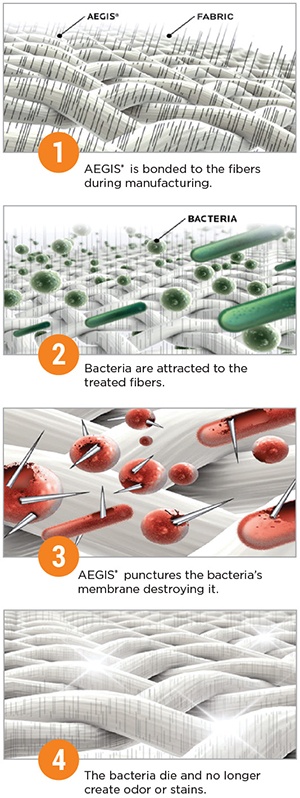 An Eye to the Future of Child Safety
An Eye to the Future of Child Safety
“Whenever we add a new safety-based system or product to our portfolio, we need it to be the best engineered and most capable system available,” Mirabile added.
Driving this innovation, he said, is the United Safety team’s belief that no child should face the prospect of injury or death while riding the bus.
“It’s something we’re passionate about, never more so than when we’re talking about our own children who ride these buses to and from school every day,” he said.


